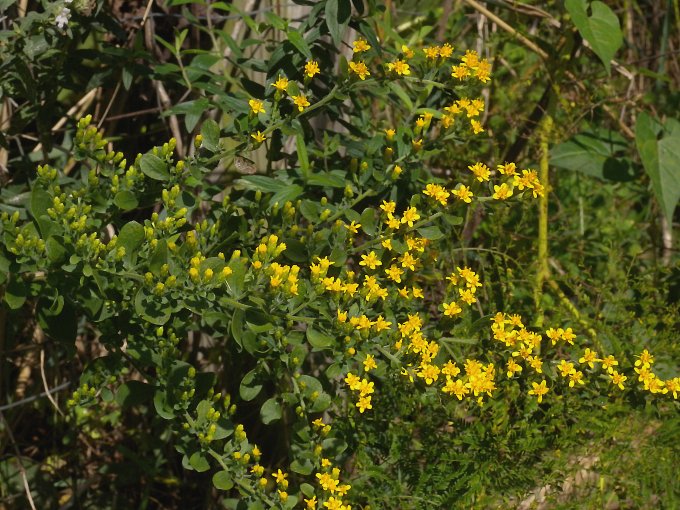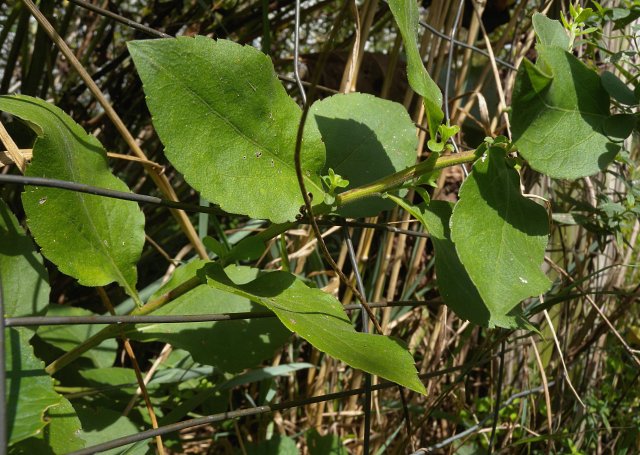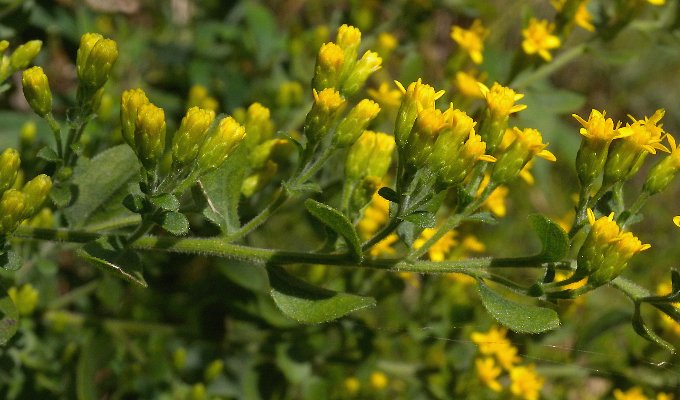
The central stem terminates in a pyramidal panicle of flowerheads that is up to 1¼' long and 1' across; the panicle is usually widest toward the lower bottom. In response to the weight of this inflorescence, there is a tendency for the entire plant to arch to one side. Relative to the orientation of the central branch of the panicle, the lateral branches are mostly ascending or ascending-arching. The branchlets terminating in flowerheads are up to 1/3" (8 mm.) long and they bend upward to hold the flowerheads in an erect position, regardless of the orientation of the panicle. Both the branches and branchlets of the inflorescence are light to medium green, terete, and densely short-pubescent. Interspersed along the branches of the inflorescence are leafy bracts up to 1" long and ¾" across; the leafy bracts are oval, broadly elliptic, obovate, or ovate in shape, while their margins are toothless. Along the terminal branchlets, there are a few leafy bractlets up to 1/8" (3 mm.) long that are green, broadly oblong in shape, and scale-like in appearance. Both the leafy bracts and leafy bractlets are medium to dark green and densely short-pubescent along their lower sides. The flowerheads (including both their involucres and florets) are about ¼" (5-6 mm.) tall and ¼" (5-6 mm.) across. Each flowerhead has 4-7 disk florets that are surrounded by 4-6 ray florets. The corollas of the disk florets are yellow and short-tubular in shape with 5 arching lobes at their apices. The petaloid rays of the ray florets are yellow, widely spreading and short-oblong in shape with 1 or 2 shallow notches at their tips. The base of each flowerhead is surrounded by scale-like phyllaries (floral bracts) in about 3 irregular series. These phyllaries are unequal in size, light green, oblong with rounded or bluntly acute tips, and appressed to together; their margins are short-ciliate. Both the disk florets and ray florets are perfect.

The blooming period occurs during early to mid-autumn, lasting about one month. Much smaller and sparsely branched panicles of flowerheads may bloom from short leafy stems that develop from the axils of the upper leaves. Fertile florets are replaced by small achenes with sessile tufts of white hair; they are distributed by the wind. The achenes are about 1.5–2 mm. long and narrowly bullet-shaped. The root system consists of a short branching rootstock, sometimes forming a small caudex on older robust plants. Sometimes clonal plants are produced from short stout rhizomes.
Cultivation: The preference is full sun to moderate shade, moist to dry conditions, and calcareous soil containing clay, loam, or rocky material. This uncommon goldenrod, notwithstanding its restricted range, adapts readily to flower gardens in a variety of situations.
Range & Habitat: The native Drummond's Goldenrod is restricted to the border counties of southwest Illinois, where it is uncommon (see Distribution Map). This goldenrod is a Midwestern endemic plant that is found primarily in Missouri and Arkansas. Habitats include borders of wooded bluffs, openings in rocky wooded bluffs, limestone glades, ledges and tops of limestone cliffs, and crevices of limestone cliffs. The bluffs and cliffs are typically located along rivers (the Mississippi River in the case of Illinois). This conservative species is found primarily in high quality natural areas.

Faunal Associations: Very little information is available about floral-faunal relationships for Drummond's Goldenrod. However, goldenrods (Solidago spp.) in general attract a wide variety of insects to their flowerheads. This includes honeybees, bumblebees, cuckoo bees (Epeolus spp.), leaf-cutter bees (Megachile spp.), long-horned bees (Melissodes spp.), little carpenter bees (Ceratina spp.), green metallic bees (Augochlorella spp.), Halictid bees (Halictus spp., Lasioglossum spp.), plasterer bees (Colletes spp.), masked bees (Hylaeus spp.), Andrenid bees (Andrena spp.), dagger bees (Perdita spp., Heterosarus spp.), ground beetles (Lebia spp.), ladybird beetles (Hippodamia spp.), Sphecid wasps, Vespid wasps, Tiphiid wasps, Syrphid flies, bee flies (Bombyliidae), Tachinid flies, flesh flies (Sarcophaga spp.), blow flies (Lucilia spp.), Muscid flies, butterflies, and day-flying moths (Robertson, 1929, & others). Other insects feed on the leaves, plant juices, and other parts of goldenrods. The larvae of a leaf beetle, Microrhopala excavata, have been observed to mine the leaves of Drummond's Goldenrod. Other insect feeders of goldenrods include other leaf beetles (Ophraella spp., Trirhabda spp.), larvae of leaf-mining flies (Calycomyza spp.), larvae of gall flies (Asteromyia spp., Rhopalomyia spp.), plant bugs (Lygus spp., Plagiognathus spp., Slaterocoris spp.), stink bugs (Euschistus spp.), aphids (Uroleucon spp.), treehoppers (Stictocephala spp.), grasshoppers (Melanoplus spp.), larvae of owlet moths (Cucullia spp.), larvae of Geometer moths (various species), and larvae of Tortrix moths (Epiblema spp., Eucosma spp., Phaneta spp.). Among vertebrate animals, the seeds of goldenrods are eaten by such songbirds as the Eastern Goldfinch, Slate-colored Junco, Tree Sparrow, and Indigo Bunting (Martin et al., 1951/1961; DeVore et al., 2004). The White-tailed Deer and Cottontail Rabbit sometimes feed on the foliage of these plants, while the Woodland Vole and other voles feed on both the foliage and seeds (Martin et al., 1951/1961).

Photographic Location: The wildflower garden of the webmaster in Urbana, Illinois.
Comments: This is one of the best goldenrods (Solidago spp.) for ornamental gardens. It should be cultivated more often. Drummond's Goldenrod resembles many other goldenrod species, but it can be distinguished as follows: 1) the leaves of Drummond's Goldenrod are unusually wide, sometimes they are almost as wide as they are long, 2) the leafy bracts of the inflorescence of Drummond's Goldenrod are also unusually wide, 3) its stems are evenly short-pubescent, rather than hairless or hairy in longitudinal lines, 4) the phyllaries, or floral bracts, of its flowerheads have either bluntly acute or rounded tips, 5) the branches of the terminal inflorescence spread rather widely, and 6) the habitats of this goldenrod are largely restricted to riverside bluffs, limestone glades, and limestone cliffs. Of the preceding characteristics, #1 and #6 above are the most distinctive. Some authors state that the leaves of this goldenrod have 3 prominent veins (a central vein and 2 lateral veins) – while this is true for some leaves, not all leaves have this characteristic.